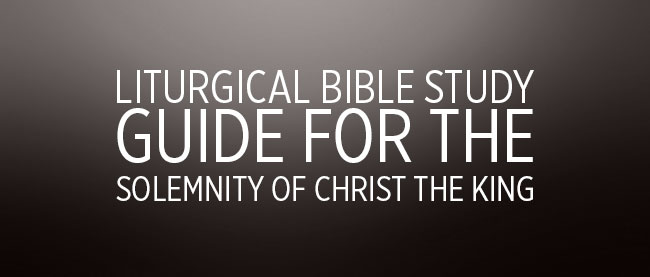Introduction
Instituted by Pius XI in 1926, this feast was celebrated on the last Sunday of October to foster the awareness of Christ’s dominion over all people and to establish peace among nations. After Vatican Council II the feast was transferred to the last Sunday of the Liturgical Year, the Sunday before Advent, on which the human race is consecrated to the Sacred Heart through the Litany of the Sacred Heart and a prayer recited before the Blessed Sacrament.
This feast celebrates Christ’s Kingship in an altogether non-worldly way. Jesus was anointed by the Father with the oil of gladness as the Eternal Priest and Universal King. As Priest He offered His life on the altar of the Cross and redeemed the human race by this one perfect sacrifice of peace. As King He claims dominion over all creation that He may present to the almighty Father a Kingdom of truth and life, a Kingdom of holiness and grace, a Kingdom of justice, love, and peace.
1st Reading – Daniel 7:13-14
Last week we heard from Daniel’s fourth apocalyptic vision as our first reading and referred to our reading for today as part of our study of the Gospel. Today’s 1st reading is from Daniel’s first apocalyptic vision, the vision of the four beasts, which occupies all of chapter 7. The Jerome Biblical Commentary and The New Jerome Biblical Commentary both say that “all exegetes now agree that the four beasts of this vision stand for the four successive pagan empires:”
a) The Babylonians
b) The Medes
c) The Persians
d) The Greeks
I am going to disagree. The Medes never occupied Jerusalem except as part of an alliance of Persians and Medes (call it Medo-Persian) under the leadership of Cyrus. I propose that the four successive pagan empires are instead:
a) The Babylonians
b) The Medo-Persians
c) The Greeks
d) The Romans
Each of these pagan empires occupied Jerusalem and each of the occupations ended in conversion of the occupier:
a) Babylonians – Nebuchadnezzar – Daniel 2:47; 4:37
b) Medo-Persians – Cyrus – 2 Chronicles 36:23; Ezra 1:2
c) Greeks – Antiochus – 1 Maccabees 6:12-13
d) Romans – Constantine – A.D. 313
The first three occupations ended in conversion to Judaism while the 4th and final one ended in conversion to Christianity.
Another, equally intriguing interpretation is that the 4th beast is the Maccabees. Although they were Jewish and took over from the Greeks, they were not of Davidic descent and therefore were occupiers rather than the rightful inheritors of the throne. Their influence ended when the Temple was destroyed in A.D. 70.
Today’s reading occurs immediately after the fourth beast has been destroyed in Daniel’s vision.
2nd Reading – Revelation 1:5-8
Today’s reading, from the book of Revelation, comes from the opening greeting and doxology; the portion of any letter which was designed to identify the writer and generally heaps flowery praise on the hearer to set the mood for the teaching which will follow. In this case, the writing is to the seven churches in the province of Asia. Although the seven churches are named, and it is evident from the descriptions which follow that he had these actual churches in mind, it is thought that the universal church is also being addressed; seven being the number of the covenant, the churches being in a circular pattern on a map, and other churches were known to exist in the area.
Gospel – John 18:33b-37
Because the Gospel of Mark is so short, and this being the last Sunday in the current cycle (Cycle B), we turn to the Gospel of John to see Jesus’ kingship described. Ordinarily when we think of kingship we imagine palaces, royal robes, sumptuous banquets, silver and gold, power and glory. But today we hear about truth, betrayal, blood, death and bitter lamentation.
Jesus has been arrested and the High Priest Annas has finished his interrogation the previous evening, and finding nothing wrong, sent Him to another high priest, Caiaphas. We were told the night was cold, and twice Peter was described as warming himself near the charcoal fire. At daybreak (Good Friday) Jesus was brought to Pilate who was unable to secure a clear indictment from the crowd and so has summoned Jesus inside the praetorium (Roman courtroom) to make a private inquiry of Jesus.
The contempt with which Pilate and the Jews regarded one another is well known. Pilate’s questioning does not necessarily mean that he is unaware of the attitude of these men toward Jesus, but he is asking for a charge against him which will have validity in Roman law. This, Jesus’ enemies did not conclusively have, hence their initial effort to bluster Pilate into doing their will without hearing specific charges. Pilate has refused to involve himself under those terms and has forced the Jews to speak bluntly of their designs on Jesus’ life.
The Gospel of John is unique in that, unlike the other three gospels, John places Jesus’ death on the cross on a different date. The synoptic gospels (Matthew, Mark, and Luke) all show the Last Supper as being a Passover meal with Jesus’ sacrifice occurring the next day. John, because of his emphasis upon the Eucharist, places Jesus death at the same time as the sacrifice of the Passover lamb. Saint John draws heavily from Old Testament Passover imagery in his narrative:
Only in John do we hear Jesus being declared “The Lamb of God (John 1:29,36).
John is very careful to place Jesus’ triumphal entry into Jerusalem on the day when the Jews are to procure the lamb for the Passover meal (Palm Sunday); they are to observe the lamb for four days to ensure that it is free from any blemishes before the animal is sacrificed (Exodus 12:3-6).
John has Pilate, after carefully examining Jesus, declare that He is without blemish: “he again went out to the Jews and said to them, ‘I find no guilt in him’” (John 18:38); “Once more Pilate went out and said to them, ‘Look, I am bringing him out to you, so that you may know that I find no guilt in him’” (John 19:4); “Pilate said to them, ‘Take
him yourselves and crucify him. I find no guilt in him’” (John 19:6), at which point He is sent to be sacrificed. It is of Pilate’s examination of Jesus that we hear about today.
John goes on to report that Jesus’ sacrifice on the altar of the cross satisfies the requirements for the Passover lamb: “But when they came to Jesus and saw that he was already dead, they did not break his legs, but one soldier thrust his lance into his side, and immediately blood and water flowed out. … For this happened so that the scripture passage might be fulfilled: ‘Not a bone of it will be broken’ [Exodus 12:46]” (John 19:33-34, 36).
All this is to show that Jesus becomes the sacrifice of the New Passover, the meal which Jesus promises in His Bread of Life Discourse (John 6:25-70). He becomes the meal which must be eaten if we are to be part of the covenant (Exodus 12:8).


